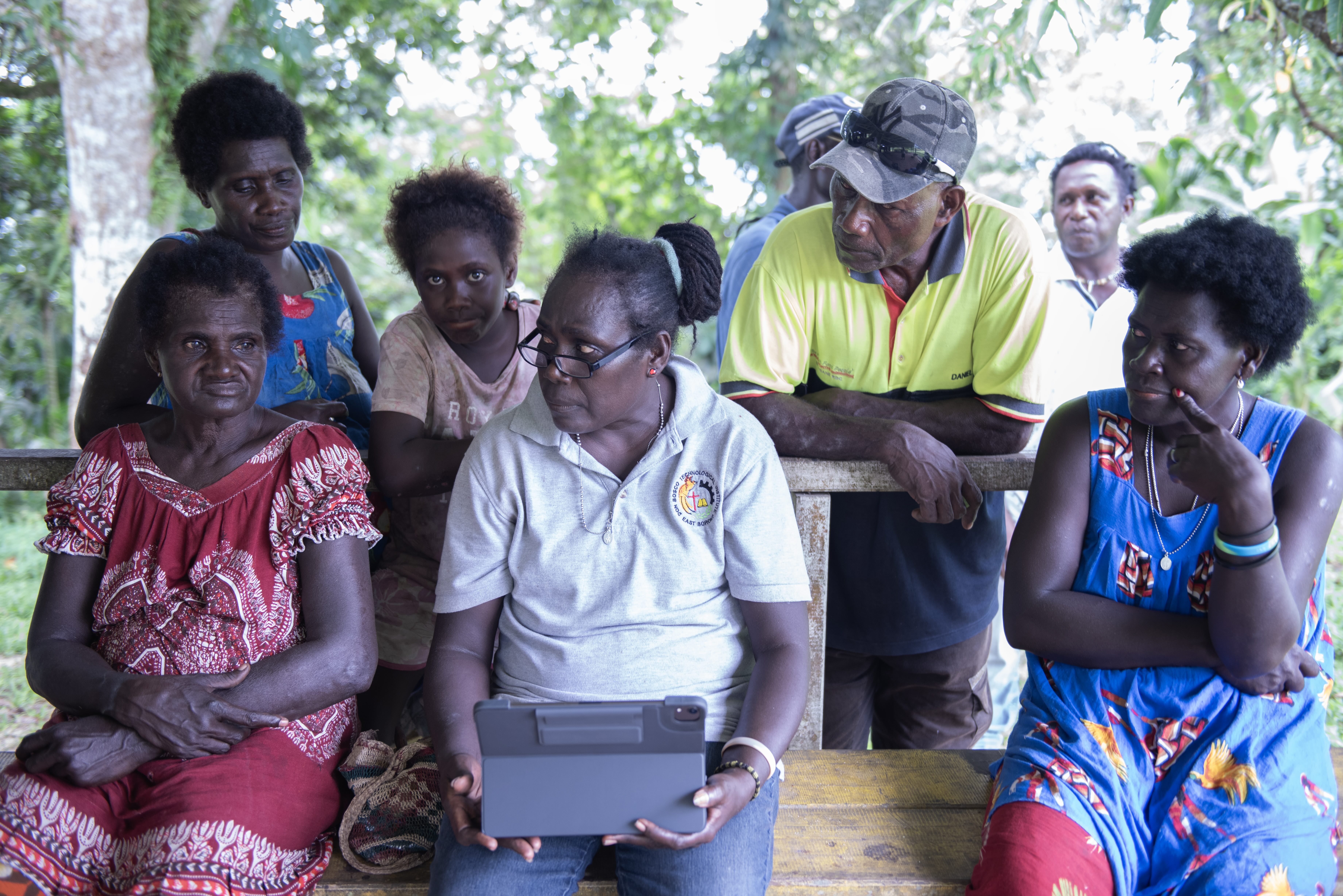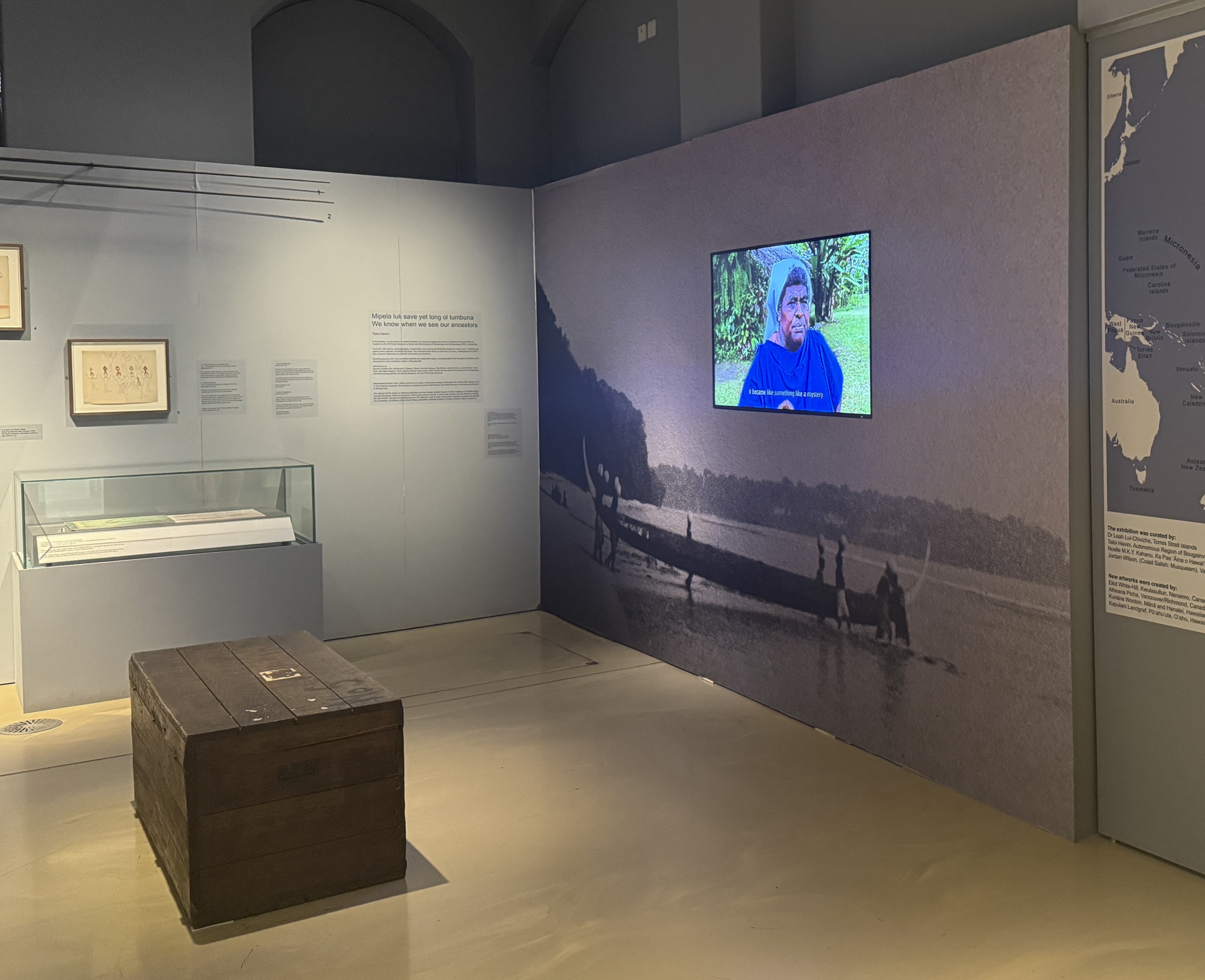04 Nov 2025 | Taloi Havini & Nicholas Thomas
In conversation with the curators of "Fault Lines" (Part 3/4): Taloi Havini
The exhibition Fault Lines: Imagining Indigenous Futures for Colonial Collections, supported by this ERC Starting Grant, opened in December 2024 and will run until December 2025 at the Museum of Archaeology and Anthropology (MAA), Cambridge. A collective, convened by Noelle M.K.Y. Kahanu with Leah-Lui Chivizhe, Taloi Havini and Jordan Wilson, curated this exhibition. In this blog series, they outline the project, through responses to questions prepared by Nicholas Thomas, director of MAA. All parts will appear jointly in a publication that is currently in progress. Read the conversations here in advance.
Taloi Havini
Could you introduce yourself and say something about the place and context you are working from? What are the core issues or priorities that shape your work as an artist / curator / activist / researcher and that you have brought to this particular project?
I descend from the Nakas clan of the Hakö people from Buka Island, in the Autonomous Region of Bougainville. Currently based in Brisbane, Australia, I am often involved in projects involving research in the North Solomons and collections held in museums in the UK and Europe.
Understanding Bougainville’s colonial and political history is important as the people still largely regard themselves as suffering under ongoing colonial legacies. The earliest period of rule was attempted by Germany, and although it was quite short lived, they had already established plantations and trade with locals, which ended around WWI when the British took over the region and capitalised on these economic inroads with claiming Crown Law over all minerals in the Territory.
By the time the second world war landed, my grandfather was hiding in the caves of Buka from the Japanese whose stronghold was in the north west Pacific. Local populations suffered greatly during these years, many stories of famine and torture are re-lived when skeletons of war machinery and airplanes are rusting away on our islands. The allied forces of Australia, New Zealand and the USA eventually won over in a sweeping victory that somehow entitled post-war Australians to receive parcels of land where they settled as “Mastas”.
Local resentment had been brewing over such colonial treatment, and by the mid to late 1970s, a large population of Bougainvilleans resisted politically to being part of Papua New Guinea (PNG) when Australia granted it independence. The majority of the island voted for complete independence from PNG in the 2021 referendum. This has not been granted and is believed to be tied to the issues of ownership concerning the Panguna copper and gold mine that was the catalyst for war and military control in 1990. One of the only cultural centres that was built during a period of cultural revival was to be destroyed during the island-wide siege.
There are very few examples left on the island showing traditional materials from this period. This is why the colonial collections in Europe and the UK are so significant to the communities in Bougainville.
 As a form of digital repatriation, descendants of Kurtachi community look at and discuss museum collections that originated from their region. Photo: Taloi Havini.
As a form of digital repatriation, descendants of Kurtachi community look at and discuss museum collections that originated from their region. Photo: Taloi Havini.
Fault Lines addresses the future of colonial-era collections in museums such as the Museum of Archaeology and Anthropology. Could you give us a sense of your engagement with museum collections, and particularly with museum collections such as those in Europe, that are now and have been for decades, if not longer, distant from communities of origin? What in other words are your starting points for imagining the future?
Accessing the MAA and Pitt Rivers collections has enabled me to delve deeper into these specific colonial histories. In tracing who, how, and where these material cultures came from in Bougainville led me to speak with fishermen and women, carvers and the descendants. Sharing this knowledge with wider members of my community was surprising, as they aren’t always aware of such holdings. This informs the way I am engaging with museums, often led by the interests that come from the community.
For this project, it was important to collaborate with artists, coastal communities, chiefs and those who had a direct connection with the items of interest from the MAA and Pitt Rivers collection. Making these available to ‘home’ communities can also be through providing printed materials and conversations that explain their histories, kind of like a form of ‘digital repatriation’. This can be the start of projects and relationships and I would encourage museums to seek partnerships between cultural institutions, universities and communities. This ensures the museum remains relevant part of society and open to dialogue and can exist meaningfully beyond what can be seen as a legacy of colonialism if open engagement is not offered.
When the opportunity arose, what artefacts and/or images from the historic collections (at MAA or otherwise in the UK) were you concerned to foreground? What particular significance does the material have?
British anthropologist Beatrice Blackwood’s collection in Oxford is quite substantial. Blackwood kept extensive field notes, letters and diaries including unpublished material that is rarely seen on public display - if ever. An enlarged black and white photo taken by Blackwood in 1929 is made into a large wallpaper with a TV monitor showing an interview with Sister Loraine Garasu that I filmed in 2024.
In the exhibition, a crate once used to ship artefacts to Britain is placed in front of the TV. In keeping with the theme of ‘tools’ and methods used in anthropological fieldwork, there are five colourful drawings that she commissioned. Blackwood wrote of her frustrations in trying to develop photos in the tropics. The typewriter was more reliable. The display includes three texts, descriptions of events and places that she entitled ‘Untaken Snapshots’ (A Social Call; Festive Dance; and the Taro Garden).
The display also consists of two long spears, fishhooks and charms, a stone pestle, one female figure, and archives authored by an anthropologist and a missionary.
Drawings photocopied from Voyce’s (1973) publication, Design work as shown on Bougainvillle arrows and spears, belonging to my parents’ collection were also included. The period when all this was ‘collected’ was around 1930 in Bougainville. People were familiar with German planters who routinely passed by decades earlier. It was a time when trade, purchase, exchange, gifting, commissions and agency was already commonplace in Bougainville.
Missionaries were among the earliest of collectors. In the 1930s, Reverend Voyce travelled the entirety of Bougainville from the southern end to the northern tip of Buka as Superintendent of Methodist work across the region. The race against growing Catholic influence meant these denominations sent out solo evangelists.
The missions were becoming fluent in learning local dialects. Such inroads into communities were considered humanist and sympathetic to local ideologies and less observational and scientific as was the approach of the anthropologists. Voyce’s father was taken by the aesthetic qualities and detail of weapons that he drew and took detailed notes of in the publication, which has become very useful in identifying materials, styles and locations.
 Sister Loraine Garasu appears in a 2024 video against the backdrop of an enlarged 1929 photo by British anthropologist Beatrice Blackwood. Photo: MAA.
Sister Loraine Garasu appears in a 2024 video against the backdrop of an enlarged 1929 photo by British anthropologist Beatrice Blackwood. Photo: MAA.
What approach did you take to contextualising and/or re-activating the material?
There are around 708 items collected by Beatrice Blackwood, including photographs, drawings and fieldnotes from her time living in Buka and Bougainville, from 28 September, 1929, to 8 October, 1930. For this kind of collection, it is worth looking at in more detail, and in May 2024, I returned to Buka and travelled to meet the descendants of the Kurtachi village as follow-up research with the descendants of the village where Blackwood lived in 1929.
I was curious to see if they knew about Blackwood and if there were any stories about her or this time. I was surprised to learn that the village does not exist today and that they were not really interested in talking about her, even though they knew about her. When I mentioned the name of her ‘main informant’ Pinari, it was a different story.
I was not surprised when they told me of their distrust of outsiders before me, wanting to come into their village and research her book. They did not allow it. It was out of respect for my father (and the Havini name) that they agreed to speak with me. Out of respect for their wishes to not be studied any further, the interview on display is with Sister Lorraine Garasu rather than the community. Here she explains her views and how the people from Kurtachi feel about the time when Blackwood lived.
It felt important to speak with fishermen and women and carvers who could speak to some of the items on display like the stone pestle, the types of hooks and arrows used for hunting. Pinari was, for example, admired for creating his own agency (and trickery).
What would you want visitors to take away from the exhibition?
That museums hold and care for collections that are highly complex. Further engagement and curation with communities can change the way people view and deepen the meanings to what they think they see.
_____________
References
Voyce, H. M. 1973. Design work as shown on Bougainville arrows and spears. Rabaul, Papua New Guinea: Trinity Press.
The conversation with Jordan Wilson will be published next month. Read the conversations with Noelle M.K.Y. Kahanu and Leah Lui-Chivizhe and learn more about the research project.

